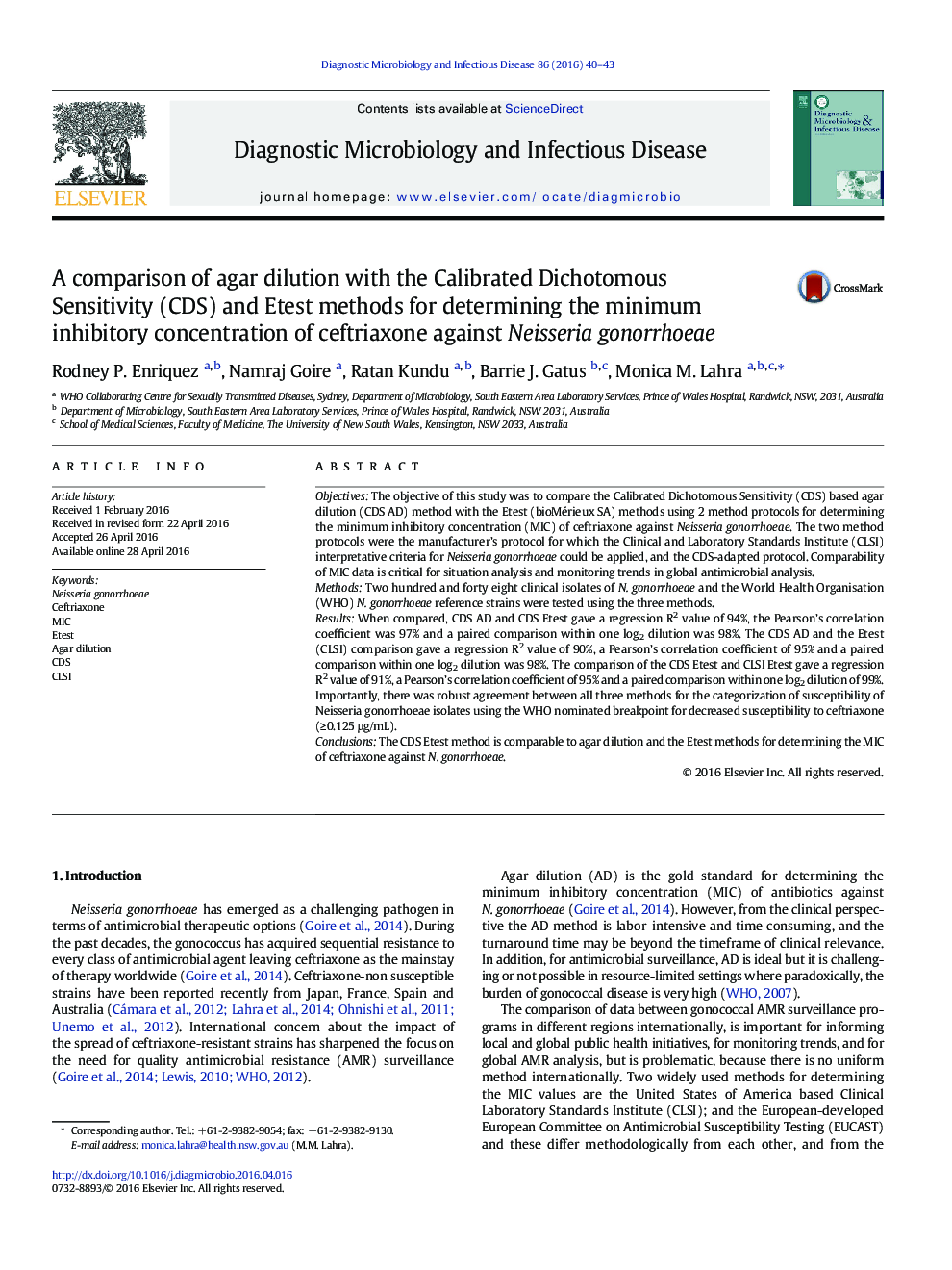| کد مقاله | کد نشریه | سال انتشار | مقاله انگلیسی | نسخه تمام متن |
|---|---|---|---|---|
| 3346787 | 1215907 | 2016 | 4 صفحه PDF | دانلود رایگان |
• The Calibrated Dichotomous Sensitivity (CDS) test method for determination of ceftriaxone MIC by agar dilution (and adapted for use by the Australian Gonococcal Surveillance Programme, AGSP) produced results for the World Health Organisation (WHO) control panel of isolates that were all within the published acceptable MIC range.
• The Calibrated Dichotomous Sensitivity (CDS) – adapted Etest method for determination of ceftriaxone MIC produced results for the World Health Organisation (WHO) N.gonorrhoeae control panel of isolates that were all within the published acceptable MIC range for each of the members of the panel.
• Ceftriaxone MIC results determined by Agar Dilution using the AGSP method strongly correlate with those determined by Etest.
• Ceftriaxone MIC results determined by the CDS – adapted Etest method strongly correlate with those determined by Etest using the manufacturer’s protocol, based on the Clinical and Laboratory Standards Institute (CLSI) recommendations for antimicrobial susceptibility testing of N.gonorrhoeae.
• This data produced from testing isolates using CLSI or CDS interpretative criteria can be compared, enabling consideration of surveillance data across systems to monitor global and local trends in resistance, and for informing local and global public health initiatives.
ObjectivesThe objective of this study was to compare the Calibrated Dichotomous Sensitivity (CDS) based agar dilution (CDS AD) method with the Etest (bioMérieux SA) methods using 2 method protocols for determining the minimum inhibitory concentration (MIC) of ceftriaxone against Neisseria gonorrhoeae. The two method protocols were the manufacturer’s protocol for which the Clinical and Laboratory Standards Institute (CLSI) interpretative criteria for Neisseria gonorrhoeae could be applied, and the CDS-adapted protocol. Comparability of MIC data is critical for situation analysis and monitoring trends in global antimicrobial analysis.MethodsTwo hundred and forty eight clinical isolates of N. gonorrhoeae and the World Health Organisation (WHO) N. gonorrhoeae reference strains were tested using the three methods.ResultsWhen compared, CDS AD and CDS Etest gave a regression R2 value of 94%, the Pearson’s correlation coefficient was 97% and a paired comparison within one log2 dilution was 98%. The CDS AD and the Etest (CLSI) comparison gave a regression R2 value of 90%, a Pearson’s correlation coefficient of 95% and a paired comparison within one log2 dilution was 98%. The comparison of the CDS Etest and CLSI Etest gave a regression R2 value of 91%, a Pearson’s correlation coefficient of 95% and a paired comparison within one log2 dilution of 99%. Importantly, there was robust agreement between all three methods for the categorization of susceptibility of Neisseria gonorrhoeae isolates using the WHO nominated breakpoint for decreased susceptibility to ceftriaxone (≥0.125 μg/mL).ConclusionsThe CDS Etest method is comparable to agar dilution and the Etest methods for determining the MIC of ceftriaxone against N. gonorrhoeae.
Journal: Diagnostic Microbiology and Infectious Disease - Volume 86, Issue 1, September 2016, Pages 40–43
